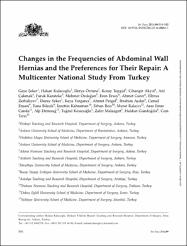Changes in the frequencies of abdominal wall hernias and the preferences for their repair: A multicenter national study from Turkey

Göster/
Erişim
info:eu-repo/semantics/openAccessTarih
2014Yazar
Şeker, GayeKulacoğlu, Hakan
Öztuna, Derya
Topgül, Koray
Akyol, Cihangir
Çakmak, Atıl
Karateke, Faruk
Özdoğan, Mehmet
Ersoy, Eren
Gürer, Ahmet
Zerbaliyev, Elbrus
Şeker, Duray
Yorgancı, Kaya
Pergel, Ahmet
Aydın, İbrahim
Ensari, Cemal
Bilecik, Tuna
Kahraman, İzzettin
Reis, Erhan
Kalaycı, Murat
Canda, Aras Emre
Demirağ, Alp
Kesicioğlu, Tuğrul
Malazgirt, Zafer
Gündoğdu, Haldun
Terzi, Cem
Üst veri
Tüm öğe kaydını gösterKünye
Seker, G., Kulacoglu, H., Oztuna, D., Topgul, K., Akyol, C., Cakmak, A., Karateke, F. ve diğerleri (2014). Changes in the frequencies of abdominal wall hernias and the preferences for their repair: A multicenter national study from Turkey. International Surgery, 99(5), 534-542. https://doi.org/10.9738/INTSURG-D-14-00063.1Özet
Abdominal wall hernias are a common problem in the general population. A Western estimate reveals that the lifetime risk of developing a hernia is about 2%.(1-3) As a result, hernia repairs likely comprise the most frequent general surgery operations. More than 20 million hernias are estimated to be repaired every year around the world.(4) Numerous repair techniques have been described to date however tension-free mesh repairs are widely used today because of their low hernia recurrence rates. Nevertheless, there are some ongoing debates regarding the ideal approach (open or laparoscopic),(5,6) the ideal anesthesia (general, local, or regional),(7,8) and the ideal mesh (standard polypropylene or newer meshes).(9,10)

















